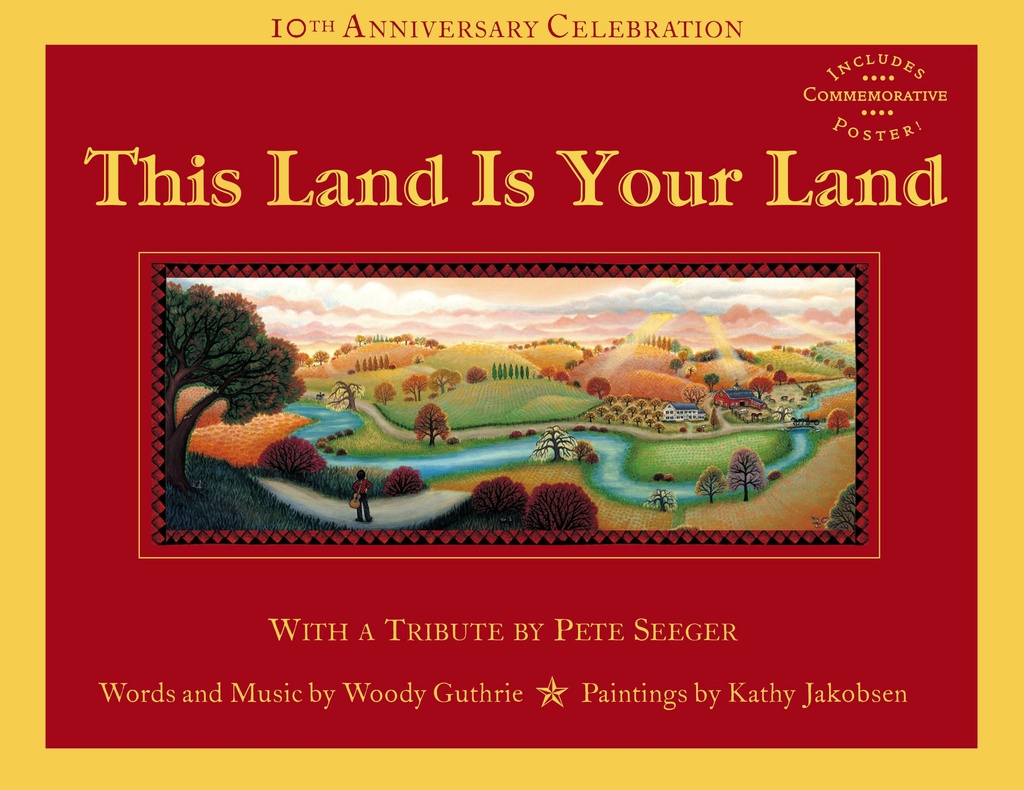

“This Land Is Your Land”; Words and Music by Woody Guthrie; paintings by Kathy Jakobsen
If you’ve ever heard or sung “This Land is Your Land” by legendary folksinger and songwriter Woody Guthrie (and I’m pretty sure you have), then you must remember that its simple melody takes you on a tune-filled journey across America.
And, happily, I recently stumbled upon this picture book with its tribute and some insights into Guthrie’s playable portrait of America, provided by Pete Seeger.
But, it is in folk artist, Kathy Jakobsen’s glorious artwork that the words and music become truly resonant for the reader, as the words of Guthrie’s song appear in paintings that are as homespun and humble as the song itself. her paintings appear as permanent collections in The American Museum of Folk Art and The Smithsonian. She has also done the paintings for a book called Johnny Appleseed, written by Reeve Lindbergh who is Charles Lindbergh’s daughter. This particular title that I’ve also blogged on is certainly worth a look too!
Did you know that Woody Guthrie wrote about a thousand folk songs, ballads and children’s songs? I didn’t. He probably set the stage for the folk music genre coming to the fore in the 1960’s. From the cover flap of this grand picture book, none other Nobel prize winner Bob Dylan and The Boss himself, Bruce Springsteen, were influenced in their work by Woody Guthrie. And Woody’s son, Arlo, has a pretty famous song too, called “Alice’s Restaurant.”
Here’s probably the most famous of the lines from “This Land is Your Land :
This land is your land, this land is my land,
From California to the New York island;
From the redwood forest to the Gulf Stream waters,
This land was made for you and me.
The first time that Pete Seeger heard “This Land is Your Land,” he heard it after it was recorded by a small recording company called Folkways, and according to Mr. Seeger, “It’s a nice idea, but the tune is too simple. This song is one of Woody’s lesser efforts.”
Shows just how wrong artists can be in critiquing one another.
You will read in Pete Seeger’s Tribute that Guthrie wrote this piece of Americana “in the windy, icy February of 19 and 40 when he hitchhiked from Los Angeles to New York City.”
Here’s Woody Guthrie’s own definition of a folk song:
“A folk song is what’s wrong and how to fix it or it could be who’s hungry and where their mouth is or who’s out of work and where the job is or who’s broke and where the money is or who’s carrying a gun and where the peace is.”
If that’s still true today, and it is, maybe we need a lot more folk songs just like Woody Guthrie’s, to give voice to them.
Lord knows the same problems exist today.
Please let your young reader have a chance to see this Publishers Weekly Notable Book, A School Library Journal Best Book, A Parenting Book of the Year and New York Times Notable Book.
How far we have come as a country in 200 plus years when a group of brave men risked their lives, fates and fortunes to start a new country with little more than their faith in a dream and a moral imperative for freedom.
It’s a fitting way to welcome in July 4th!
